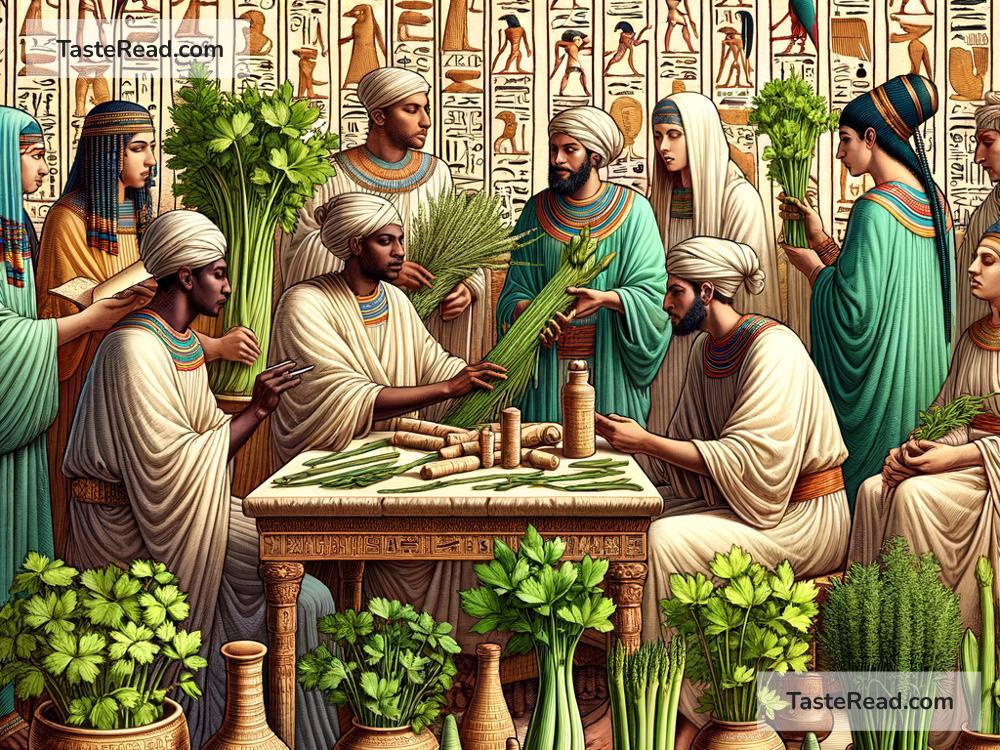The Curious Story of Celery in Ancient Egyptian Medicine
When we think of celery today, we imagine it as a crunchy snack, a flavorful addition to soups, or a healthy ingredient in juice. But few people know that celery has a fascinating history that dates back thousands of years and holds an important place in the world of ancient Egyptian medicine and culture.
Celery in Ancient Egypt: More Than Just a Herb
Celery, or something very similar to the plant we know today, grew naturally along the Nile River in Egypt. The Egyptians were famous for their deep knowledge of plants and their uses not only in food but also in healing. Plants and herbs were an essential part of their medical practices, and celery was no exception.
In ancient Egypt, celery wasn’t just valued as a food; it had a symbolic significance and was often linked to death and the afterlife. Drawings and carvings of celery-like plants, with their long stalks and feathery leaves, have been found in tombs and temples. This indicates that celery played a role in funerary rituals and prayers for the dead. It was believed that certain plants had protective or purifying qualities, and celery was thought to be among them.
A Medicinal Plant with Wide Uses
The ancient Egyptians were skilled herbalists, and their medical traditions focused on natural remedies. These remedies often used plants like celery for treating illnesses. Celery, or its wild relative, was believed to have healing properties for several ailments.
-
Cooling and Soothing: Ancient Egyptian medical texts mention using plants similar to celery to reduce inflammation and provide relief from pain. Its cooling nature made it useful for treating fevers or irritations of the skin.
-
Digestive Aid: Celery was likely used as an ingredient to help with stomach issues, much like it is today. The plant’s fibrous nature and ability to regulate digestion made it useful in remedies for improving overall gut health.
-
Natural Diuretic: Ancient Egyptians were aware of celery’s ability to aid the body in removing excess fluids. It may have been prescribed for illnesses related to water retention or kidney health.
-
Calming Properties: There are indications that celery had a reputation for calming the mind. Egyptians valued plants that could bring balance to the body and spirit, and celery could have been one such herb.
Celery’s Role in Religion and Symbolism
In addition to its medical uses, celery had symbolic and ceremonial importance for the Egyptians. The plant was associated with the gods and the afterlife. Some historians believe that celery-like plants adorned wreaths or decorative arrangements used in burial ceremonies. These wreaths were placed on mummies or in tombs as an offering to the gods, possibly to ensure safe passage to the afterlife.
Interestingly, celery’s connection with death isn’t unique to ancient Egypt. In ancient Greece, centuries after the Egyptians, celery also became a symbol of mourning, and it was often used in funerals.
How Did Ancient Egyptians Know So Much?
The Egyptians were extraordinary observers of nature and health. Their knowledge of plants often came from trying things out and observing results over long periods of time. The famous “Ebers Papyrus,” an ancient Egyptian medical document dating back to around 1550 BCE, lists hundreds of treatments and herbs, showcasing the depth of their medical knowledge. Celery-like plants figure prominently in such texts.
Their doctors, known as “sunu,” were highly respected and treated patients with a combination of practical remedies, spiritual rituals, and prayers. Plants were often crushed, boiled, or mixed with other ingredients to create ointments, drinks, or salves.
What Happened to Celery?
While celery remained important in Egyptian medicine and culture for centuries, its use evolved over time. As trade grew between Egypt and other parts of the world, the knowledge and uses of celery were passed to other civilizations. For example, the ancient Greeks and Romans adopted celery for its medicinal and culinary qualities.
Throughout history, celery has been cultivated and transformed into the plant we recognize today. Modern celery likely originated from a wild variety, like the kinds the ancient Egyptians knew. Today, this humble vegetable has lost much of its symbolic weight but is still appreciated for its health benefits.
Lessons from the Past
The story of celery in ancient Egyptian medicine reminds us of the creativity and resourcefulness of our ancestors. They didn’t separate science from spirituality; instead, they saw medicine, faith, and nature as interconnected parts of life. Celery was more than a food—it was a symbol, a medicine, and, in many ways, a mystery.
The next time you enjoy celery, take a moment to appreciate its long history. From ancient tombs to modern kitchens, this simple plant has touched lives in ways far beyond its crunch. Who knew that something so ordinary today once had such extraordinary significance?
In the end, celery’s curious story in ancient Egyptian medicine teaches us one thing: even the simplest plants can hold surprising secrets. History is full of reminders that there’s always more than meets the eye, even in the world of vegetables!


